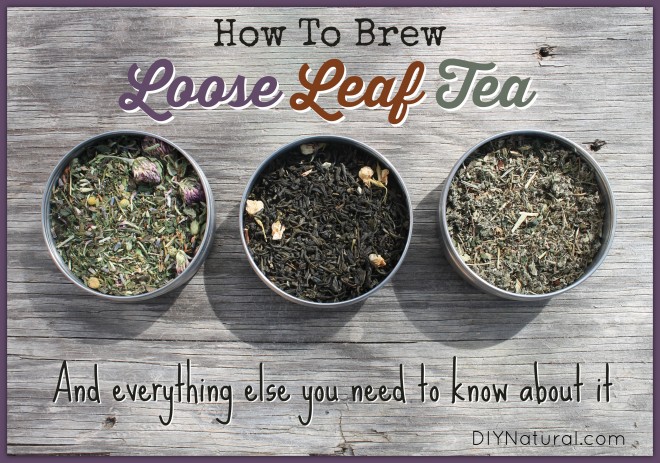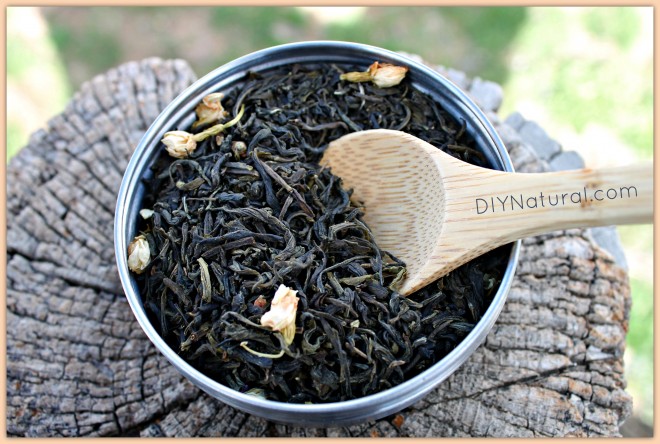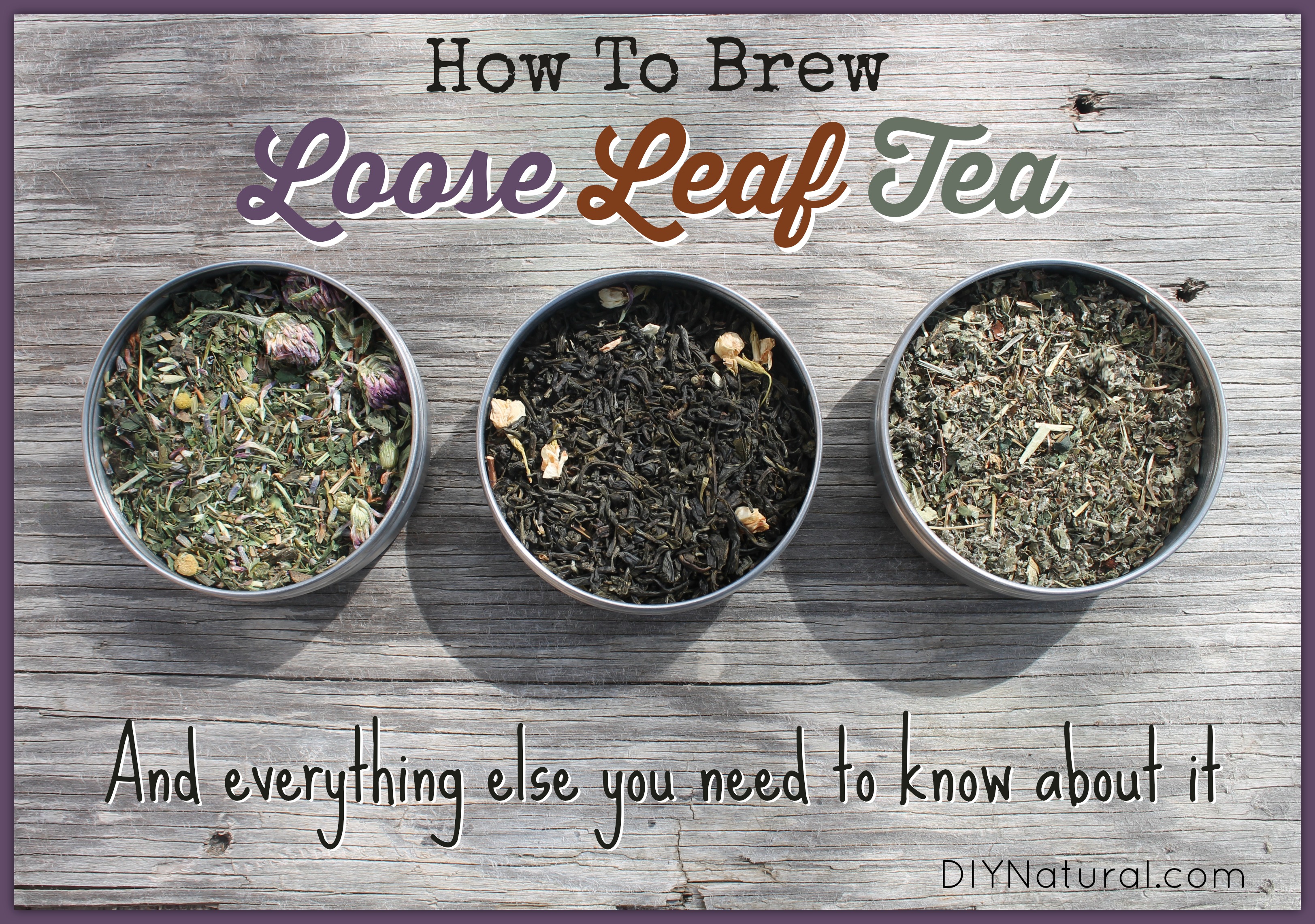
What do you call a person who takes her own tea with her, oh, everywhere, so she can always be sure she has something delicious to steep in hot water? A tea snob. At least, that’s the nickname I earned from my husband for doing just that.
I’ve loved tea for as long as I can remember. Growing up on a farm with “herb & tea” in the name, we always had plenty of it. And because my dad has a knack for making amazing blends, there was always an abundance of delicious teas of all varieties.
While we had some bagged tea, the majority of it was loose leaf. Sure it took a little extra work, but the end result was always fresher and more flavorful. It also tasted a whole lot better than your standard bagged orange pekoe.
Benefits of loose leaf tea
Aside from the obvious health benefits of tea itself, loose leaf tea offers some great qualities particularly for the natural-minded DIY-er.
Bulk buying
Buying loose leaf tea in bulk is a great way to save money and sample small amounts of tea before you invest in larger qualities. (Keep it in small glass pantry jars or metal tins.) Or, you can keep many different types of tea on hand. You can also lower waste by reusing the same container when you buy your tea.
Bag-free
Some tea bags are made with plastic, which may leach harmful chemicals into your tea because of the high temperature of water. Paper tea bags are often treated with a carcinogenic chemical that has been shown to cause infertility (source). Loose leaf tea is the safest option, especially if you can get organic.
DIY blends
Have you ever mixed lavender buds with Earl Grey tea? It’s delicious! There are lots of other blends you can experiment with if you try loose leaf tea that you just can’t do with pre-bagged teas. Like this sleepy blend or this wonderful blend for women.
Types of loose leaf tea
Before we get into how to prepare tea, I want to give you a quick breakdown of the different types of tea available. You can find several different varieties of each type and I encourage you to sample as many as possible so you can find your favorites.
- Herbal: Herbal teas are typically made of leaves, flowers and berries of different herbs. Try herbs solo, like a cup of chamomile or lemon balm tea, or in a yummy blend. (Find several different organic herbal teas here.)
- Green: One of the many types of tea from the Camellia sinensis plant, green tea leaves are picked, dried and heat-treated to stop fermentation. (Find a variety of organic green teas here.)
- Black: Black tea also comes from Camellia sinensis and the leaves are fully fermented to produce strong flavor. (Find many varieties of organic black tea here.)
- Red: Red teas, like rooibos and honeybush are red because of their unique fermentation process. They also lack the astringent tannins found in green and black teas. (Find several organic red tea varieties here.)
- White: White tea also comes from the Camellia sinensis plant. It’s the least processed of all the tea varieties, typically using the youngest tea leaves that are lightly steamed and dried.
- Mate: Made from the leaves of the Yerba mate plant, native to Argentina. Mate tastes a lot like coffee and is often served in a gourd with a filtered straw. (Find organic Yerba Mate tea here.)
- Oolong: Also from the Camellia sinensis plant. However, when oolong tea leaves are picked, they are then bruised and allowed to ferment for a short period of time. (Find organic oolong tea here.)
Where to get loose leaf tea
Bulk section
If you have a local store that offers bulk herbs and spices, you’ll likely find bulk teas as well. The assortment typically depends on the size and type of store you visit.
Mountain Rose Herbs
Mountain Rose Herbs is our favorite source of organic herbs and teas. They offer a large selection in different amounts so you can buy a lot or a little at a time. I highly recommend the Vanilla Rooibos and Blossoms of Health blend. (Shop for other Mountain Rose Herbs organic loose leaf teas here.)

How to prepare loose leaf tea
Most teas only require a short period of time to steep. One to three minutes will yield a nice flavor. Longer than that and you may end up with a bitter flavor. Herbal teas, however, can be steeped longer and I usually steep them for at least five minutes.
Ingredients needed
- 12 oz. hot filtered water (find the best filtration systems here)
- 1 tablespoon loose leaf tea (find many organic varieties here)
- cup/mug
- straining device – my favorite is the brewing basket, though tea balls and muslin bags work well, too
Directions
Place loose leaf tea in your tea strainer of choice, then put it in your favorite mug. Boil water in your tea kettle (remove right before it boils for green and white tea), then remove from heat. Pour over the tea and let steep for 1-3 minutes.
Serve plain or add a little natural sweetener like raw honey and/or a touch of cream.
What’s your favorite type of tea?
*******




I want to make herbal iced tea. How can I strain that over a large pot and how much loose tea should I use?
I too am a Tea “snob”. I have even supplied my children with jars of tea I drink for their homes!
Thank you for the article it was very informative.
Love this one.
Would be more if u could write in one of your posts more about herbal tea.
As I live i North Europe, Latvia, we have loads of possibilities of picking and growing our own herbal tea. Thats how my mom tought me.
Its said that herbal tea you should not make strong as the bitterness decreases its health benefits. As well herbal tea is no good if you pour over boiling watter. Best is 50º to 60º Celsius.
I DO NOT DRINK HOT TEA,,I LIKE ICE TEA WITH A NATURAL TASTE,,NO CREAM AND SUCH IN MY TEA CAN I GET BULK TEA LIKE THIS.
Wonderful article – thanks. Loved the part about Rooibos tea.
I live in South Africa and we are raised drinking Rooibos. Some of my fondest memories are school winter holidays when my mom would make us a pot of Rooibos tea for tea time. Her method may not have been the newest or healthiest but it produced a piece of heaven in a cup.
You would brew the loose tea leave in a kettle water on the stove for about 10 minutes. This would release the aroma of the tea that would fill the whole house. It was also believed that this is the only way to get all the benefits of Rooibos tea. It would produce a strong red colored tea that we would then drink with a teaspoon of condense milk in it and sugar to taste. Yes, a very sweet tea, but just the thing to drive the cold away.
Today you get different bags of Rooibos in South Africa in the stores and one of my favorites is Rooibos, vanilla and honey. This is a wonderful flavorful tea that you can drink without adding anything additional to it – pure goodness.
where can you get regular loose leaf tea in bulk???
Great article about a topic I have wondered a lot about. Thank you for clearing it up 🙂 Love my tea 🙂